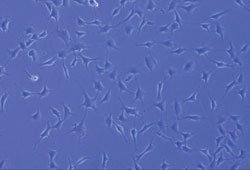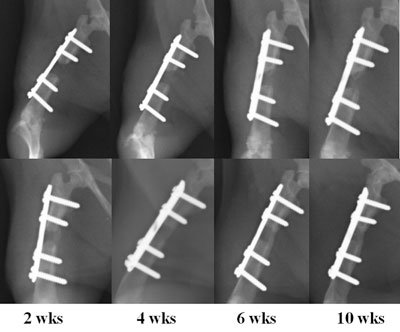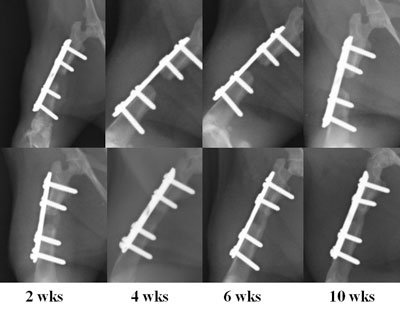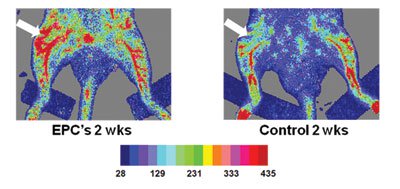Bone defect healing and vascularity seen after using endothelial progenitor cell therapy
Animal study shows impressive radiographic defect healing with EPC vs. mesenchymal stem cell therapy.
Endothelial progenitor cells showed much better potential than mesenchymal stem cells for fracture healing and angiogenesis in a recent animal study.
This finding led the researchers to ponder potential uses for endothelial progenitor cells (EPCs) in orthopedic trauma as an angiogenic and osteogenic cell-based therapy for fracture healing and alternative to bone grafting.
EPCs, found in bone marrow and peripheral blood, have been shown to differentiate into various forms of neovascularized tissue. They have been successfully implanted in patients following myocardial infarction, said Aaron Nauth, MD, who presented results of using EPCs in a syngeneic rat model at the 2010 Annual Meeting of the American Academy of Orthopaedic Surgeons.
“EPCs implanted on gel-foam are able to heal critical size bone defects in a femur model. They appear to be superior to more conventional therapies with MSCs,” Nauth said.
 |
 |
|
Microscopic appearance of EPCs (left) and MSCs (right). Images: Nauth A |
|
Critical defects
Nauth and colleagues from Toronto, explored the potential of ESCs in orthopedic trauma applications using 21 syngeneic rats, in which they created 21 femoral defects. In seven rats each they added either cultured expanded EPCs or mesenchymal stem cells (MSCs) taken from bone marrow, or gel-foam and saline alone.
|
|
Results showed the defects created were of a critical size since there was a 100% nonunion rate in the control group. At 2 weeks post-treatment, the EPC group showed evidence of callus formation. By 4 weeks researchers saw bridging bone in that group, with further healing continuing through 10 weeks.
“Perhaps more surprisingly, when we compared the EPCs and the MSCs, we saw a 100% rate of nonunion in the MSC group,” Nauth said, noting that healing was not evident on radiographs or micro CT in either the control or MSC groups “in contrast to the impressive healing that we saw with the EPC therapy.”
|
|
In pursuing another aim of their work, which was to understand the angiogenic capacity of EPCs in the context of fracture healing, researchers analyzed laser Doppler imaging results in the rats studied to assess soft tissue vascularity during osteotomy healing vs. the contralateral untreated limbs.
They also placed a laser Doppler probe on the rats’ bone to determine blood flow at the fracture gap, as well as distal and proximal to it.
Increased blood flow
Both EPC and control groups demonstrated increased soft tissue blood flow early after surgery that was similar between the two groups. Beginning at approximately 2 weeks and continuing at 3 weeks, significantly increased soft tissue blood flow was seen in the EPC group versus controls In results with the probe, blood flow at the bony level in the EPC group was significantly higher than controls at 3 weeks.
|
|
“Together these results suggest that EPCs are effective for therapeutic angiogenesis and osteogenesis and fracture healing,” Nauth said. – by Susan M. Rapp
References:
- Nauth A, Li R, Schemitsch EH. Endothelial progenitor cells (EPCs) for fracture healing and angiogenesis: A comparison with MSCs. Paper #384. Presented at the 2010 Annual Meeting of the American Academy of Orthopaedic Surgeons. March 9-13, 2010. New Orleans.
- Aaron Nauth, MD, can be reached at St. Michael’s Hospital Annex, 38 Shuter St., Room 3005, Toronto, M5B 1A6 Canada; 416-627-3192; e-mail: aaron.nauth@utoronto.ca. He received research/institutional support from Stryker, Synthes and Zimmer.
The EPCs have been shown to have a positive effect on angiogenesis in previous animal studies, and the authors hypothesized that these cells would be more effective in new bone and blood vessel formation compared to a population of standard progenitor cell population of MSCs and a control group without cell therapy.
The two cell populations were harvested from syngeneic rats, and grown ex vivo prior to placement into the critical sized defects. Bone growth was assessed histologically and radiographically, and new blood vessel formation was determined histologically and using laser Doppler to assess blood flow. The EPCs showed significantly greater evidence of bone healing and blood vessel formation than the MSC and control groups, and the authors concluded that EPCs are superior to both MSC and control groups for healing these bone defects and stimulating angiogenesis to the site of bone repair.
These findings from this well-executed study suggest that EPCs may be promising for cell based therapies; however, ex-vivo techniques have the disadvantage of needing to have a second-stage procedure. Further work needs to be done to determine whether these results apply to higher animal models.
– Theodore Miclau III, MD
Orthopaedic
Trauma Institute
San Francisco General Hospital
Department of
Orthopaedic Surgery
University of California, San Francisco



